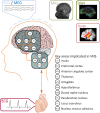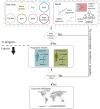Vagus nerve stimulation for epilepsy: A narrative review of factors predictive of response
- PMID: 39412361
- PMCID: PMC11647441
- DOI: 10.1111/epi.18153
Vagus nerve stimulation for epilepsy: A narrative review of factors predictive of response
Abstract
Vagus nerve stimulation (VNS) is an established therapy for drug-resistant epilepsy. However, there is a lack of reliable predictors of VNS response in clinical use. The identification of factors predictive of VNS response is important for patient selection and stratification as well as tailored stimulation programming. We conducted a narrative review of the existing literature on prognostic markers for VNS response using clinical, demographic, biochemical, and modality-specific information such as from electroencephalography (EEG), magnetoencephalography, and magnetic resonance imaging (MRI). No individual marker demonstrated sufficient predictive power for individual patients, although several have been suggested, with some promising initial findings. Combining markers from underresearched modalities such as T1-weighted MRI morphometrics and EEG may provide better strategies for treatment optimization.
Keywords: EEG; MRI; VNS; Vagus nerve stimulation; prediction.
© 2024 The Author(s). Epilepsia published by Wiley Periodicals LLC on behalf of International League Against Epilepsy.
Conflict of interest statement
None of the authors has any conflict of interest to disclose. We confirm that we have read the Journal's position on issues involved in ethical publication and affirm that this report is consistent with those guidelines.
Figures



References
-
- Kwan P, Arzimanoglou A, Berg AT, Brodie MJ, Allen Hauser W, Mathern G, et al. Definition of drug resistant epilepsy: consensus proposal by the ad hoc task force of the ILAE commission on therapeutic strategies. Epilepsia. 2010;51:1069–1077. - PubMed
-
- Carrette S, Boon P, Vonck K. A prestimulation evaluation protocol for patients with drug resistant epilepsy. Seizure. 2017;44:137–142. - PubMed
-
- Englot DJ, Chang EF, Auguste KI. Efficacy of vagus nerve stimulation for epilepsy by patient age, epilepsy duration, and seizure type. Neurosurg Clin N Am. 2011;22(4):443–448. - PubMed
-
- Elliott RE, Morsi A, Kalhorn SP, Marcus J, Sellin J, Kang M, et al. Vagus nerve stimulation in 436 consecutive patients with treatment‐resistant epilepsy: long‐term outcomes and predictors of response. Epilepsy Behav. 2011;20(1):57–63. - PubMed
-
- Toffa DH, Touma L, El Meskine T, Bouthillier A, Nguyen DK. Learnings from 30 years of reported efficacy and safety of vagus nerve stimulation (VNS) for epilepsy treatment: a critical review. Seizure. 2020;83:104–123. - PubMed
Publication types
MeSH terms
Grants and funding
LinkOut - more resources
Full Text Sources
Medical

